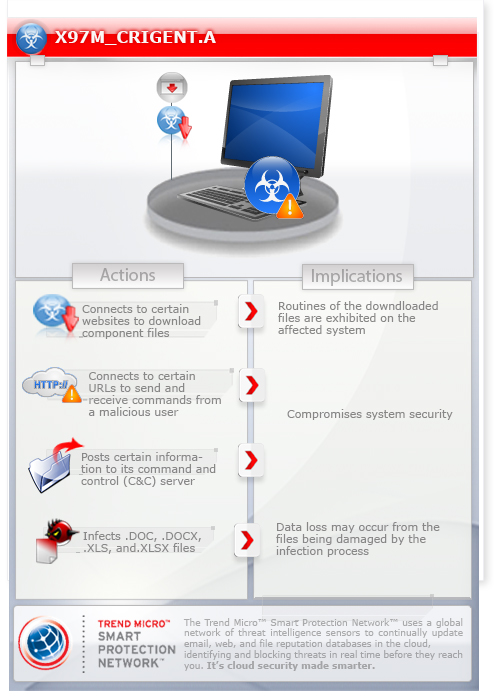X97M_CRIGENT.A
Windows 2000, Windows Server 2003, Windows XP (32-bit, 64-bit), Windows Vista (32-bit, 64-bit), Windows 7 (32-bit, 64-bit)


Threat Type: Backdoor
Destructiveness: No
Encrypted: No
In the wild: Yes
OVERVIEW
Downloaded from the Internet, Infects files, Dropped by other malware
This malware may arrive as an infected Word or Excel document. It uses Windows PowerShell to carry out its malicious routines.
To get a one-glance comprehensive view of the behavior of this Backdoor, refer to the Threat Diagram shown below.

This backdoor arrives on a system as a file dropped by other malware or as a file downloaded unknowingly by users when visiting malicious sites.
TECHNICAL DETAILS
Varies
XLS
Yes
08 Mar 2014
Compromises system security, Downloads files
Arrival Details
This backdoor arrives on a system as a file dropped by other malware or as a file downloaded unknowingly by users when visiting malicious sites.
Installation
This backdoor creates the following folders:
- %ApplicationData%\{GUID}
Autostart Technique
This backdoor adds the following registry entries to enable its automatic execution at every system startup:
HKEY_CURRENT_USER\Software\Microsoft\
Windows\CurrentVersion\Run
{GUID} = "wscript.exe %ApplicationData%\{GUID}\{GUID}.vbs"
Backdoor Routine
This backdoor opens the following ports:
- 8123 - Used for Web Proxy (Polipo)
- 9050 - Used for traffic encryption (TOR)
It connects to the following URL(s) to send and receive commands from a remote malicious user:
- http://{BLOCKED}jqj42hu.onion/get.php?s=setup&mom=04B69000-BC25-11E0-0000-3CD92B4C7E25&uid={GUID}
- http://{BLOCKED}jqj42hu.onion/get.php?s=setinfo&uid={GUID}
It posts the following information to its command and control (C&C) server:
- IP Address
- Country code
- Country name
- Region code
- Region name
- City
- Zipcode
- Latitude
- User account privilege
- OS version
- OS architecture
- Domain
- OS Language
- Microsoft Office applications
- Microsoft Office application versions
Download Routine
This backdoor connects to the following URL(s) to download its component file(s):
- http://i.{BLOCKED}n.de/
- http://gg.{BLOCKED}z.cc/
- http://i.{BLOCKED}n.de/
It saves the files it downloads using the following names:
- %ApplicationData%\{GUID}\{GUID}.zip - contains 'tor.exe' and 'polipo.exe'
- %ApplicationData%\{GUID}\tor.exe
- %ApplicationData%\{GUID}\polipo.exe
- %ApplicationData%\{GUID}\{GUID}.vbs - C&C generated file
Other Details
This backdoor connects to the following URL(s) to get the affected system's IP address:
- http://freegeoip.net/json/
It drops the following file(s)/component(s):
- %ApplicationData%\{GUID}\roaminglog - TOR initialization log
NOTES:
This backdoor requires the application Windows PowerShell to execute properly.
This backdoor retrieves the infection routine from the C&C server to infect files with the following extension:
- *.doc
- *.docx
- *.xls
- *.xlsx
This backdoor saves a copy of each *.docx files to *.doc format and *.xlsx files to *.xls format under the same directory and deletes the original file.
This backdoor lowers the security setting of the following applications:
- Microsoft Office Word
- Microsoft Office Excel
SOLUTION
9.700
10.656.02
11 Mar 2014
10.657.00
11 Mar 2014
Step 1
Before doing any scans, Windows XP, Windows Vista, and Windows 7 users must disable System Restore to allow full scanning of their computers.
Step 2
Restart in Safe Mode
Step 3
Delete this registry value
Important: Editing the Windows Registry incorrectly can lead to irreversible system malfunction. Please do this step only if you know how or you can ask assistance from your system administrator. Else, check this Microsoft article first before modifying your computer's registry.
- In HKEY_CURRENT_USER\Software\Microsoft\Windows\CurrentVersion\Run
- {GUID} = "wscript.exe %ApplicationData%\{GUID}\{GUID}.vbs"
- {GUID} = "wscript.exe %ApplicationData%\{GUID}\{GUID}.vbs"
Step 4
Search and delete these folders
- %ApplicationData%\{GUID}\{GUID}.zip
- %ApplicationData%\{GUID}\tor.exe
- %ApplicationData%\{GUID}\polipo.exe
- %ApplicationData%\{GUID}\roaminglog
- %ApplicationData%\{GUID}\{GUID}.vbs
Step 5
Restart in normal mode and scan your computer with your Trend Micro product for files detected as X97M_CRIGENT.A. If the detected files have already been cleaned, deleted, or quarantined by your Trend Micro product, no further step is required. You may opt to simply delete the quarantined files. Please check this Knowledge Base page for more information.
Step 6
Scan your computer with your Trend Micro product to delete files detected as X97M_CRIGENT.A. If the detected files have already been cleaned, deleted, or quarantined by your Trend Micro product, no further step is required. You may opt to simply delete the quarantined files. Please check this Knowledge Base page for more information.
NOTES:
Did this description help? Tell us how we did.

